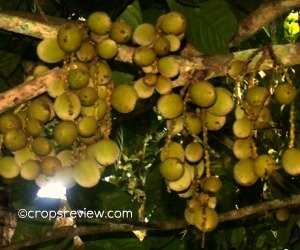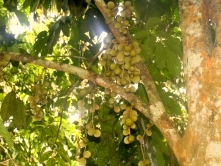Lanzones, also known as langsat, is here used as a generic term for the fruit crop which is scientifically named Lansium domesticum (family Meliaceae).
However, langsat is commonly used also to refer to a particular type or form.
L. domesticum is a complex plant species having many variants, with wild and cultivated forms which are generally parthenocarpic and in which apomixis is common.
Lanzones is a tree that grows up to a height of about 30 meters with a trunk 75 cm in diameter.
However, cultivated trees are only 5-10 m in height.
Inflorescences bearing perfect flowers emerge from the trunk and largest branches.
The fruit is a berry with 1-3 seeds, enveloped by a fleshy aril. Some cells may consist of aril tissue without developed seeds.
The fruit is always eaten fresh by squeezing it until the skin splits, and then the arils, which may have or without seeds, are freed from their segments.
Those whitish arils are the ones that are eaten.
Seedless fruits may be bottled in syrup.
The dried fruit peels have been used also to drive mosquitoes away by burning them with charcoal.
The tree is mainly grown as an intercrop under coconut or mixed with durian and other trees which serve as companion trees that provide shade.
It thrives only in sheltered and humid environments with elevations up to 800 m but prefers near sea level.
It does not tolerate water stress and high light intensity.
It prefers soils with good drainage and water retention, rich in organic matter, and slightly acidic. Lanzones dislike sandy coastal soils and alkaline soils.
Common names used in classifying various types of lanzones are: langsat, duku, duku-langsat, and longkong.
Langsat is generally used for slender trees having upright branches with sparse, dark green leaves.
The spikes are long, carrying 15-25 fruits. The fruits are ovoid in shape, thin-skinned, and exude latex until fully ripe. The taste is generally sub-acid.
The tree is adapted to more seasonal climates than the duku.
Examples are the ‘Uttaradit’ of Thailand and the ‘Paete’ of the Philippines.
Dukus are spreading trees with bright-green leaves. The spikes are shorter, usually with few fruits.
The fruits are normally larger and more rounded than those of the langsat, thick-skinned, and relatively latex-free.
Dukus are generally sweet and aromatic; the trees appear to be more adapted to humid tropical climates. An example is the ‘Du 1’ from Malaysia.
The duku-langsat of Malaysia has characteristics intermediate to those of the duku and langsat.
However, it is not easy to identify exactly the duku-langsats.
The Longkong of southern Thailand which is gaining commercial preference is nearly seedless with brittle skin and soft aril. Different horticulturists vary in their classification of the tree.
Some group it with the dukus, others with the duku-langsats (Verheij and Coronel 1992).
Lanzones trees grow slowly.
They are shallow-rooted and depend on a layer of litter to protect the numerous surface-feeding roots.
Trees start fruiting normally 10-15 years from seed. However, with proper care seedlings may bear within 7-8 years. Grafted longkong trees in Thailand bear within 5-6 years.
The use of advanced or large planting materials (LPM) which are more mature may also result in earlier fruiting.
The inflorescences usually emerge in the dry season and may fully bloom in about 7 weeks. The fruit ripens 14-17 weeks later or about 98 to 119 days after full bloom.
The harvesting season is short, with the langsat types usually ripening ahead of the others.
In Thailand and in the Philippines, the fruit is available in 4 months from July to October but 8 months in Peninsular Malaysia from June to February.

In certain areas the duku-langsats produce two crops per year, however, it is not clear whether individual trees produce more than one crop per year or the fruits were produced alternately by different trees.
There is a tendency to biennial bearing in the Philippines, that is, fruiting only every other year.
The yield of lanzones varies.
The potential fruit yield of ten-year-old longkong trees is 40-50 kg and 80-150 kg at 30 years.
It has been reported that the maximum yield is 300 kg per tree.
The average yield per hectare is 2.5 tons in the Philippines. In Thailand, the average yield is 3.6 tons for the langsat and 5.6 tons per hectare for the duku type.
The production guide that follows is for general reference purposes:
How to Grow Lanzones: A General Reference
Plant Propagation
Lanzones are commonly propagated from seed or from wildlings which naturally grow under the trees.
Only large seeds should be used to ensure high seedling vigor.
These seeds are better sown immediately because they are recalcitrant just like other members of the family Meliaceae.
Initial seedling growth is very slow. It may take 10-18 months or more for the seedling to reach pencil size or grafting size.
It can also be propagated by softwood cuttings, air layering or marcotting, budding, and the more preferred grafting (veneer, cleft, and suckle grafting).
(Click here to go to the main page on plant propagation)
Planting
Recommended plant-to-plant distance vary, from 8 m x 8 m in the Philippines to 12 m x 12 m for the longkong types in southern Thailand.
There is a report, however, that longkong trees can be grown 6 meters apart in the Philippines (Sarian, 2010).
Outplanting is preferably done at the onset and just before the end of the rainy season.
But in places with well-distributed rainfall or where irrigation is available, planting can be done at any time.
Planting holes maybe 50 cm wide and deep. 5 kg of farm manure and 100 gm of complete fertilizer are deposited at the bottom and covered with a layer of soil before planting.
When the seedling is set in, the hole is refilled with topsoil and watered immediately.
Care of Trees
Young trees are provided with shade and watered regularly during the first few years.
The main stem of the upright langsat types may be cut back 80-100 cm from the ground and the emerging branches trained horizontally.
In older trees, only watersprouts and diseased branches may be pruned. Weeding and mulching should be practiced regularly.

Irrigation can advance the flowering of lanzones by one or two months if the floral initials have emerged during the preceding dry months.
A regular supply of water to fruiting trees is especially important during drought.
A dry period during the fruit development stage may cause crop losses due to fruit cracking when water becomes suddenly available.
The use of both organic and inorganic fertilizers is recommended.
The recommended rates are 5 kg of farm manure (preferably compost) and 500 gm of complete fertilizer per year for the one-year-old trees, split into 2 to 4 applications.
For old trees, the rates can be as high as 50 kg of manure and 2.5 kg of inorganic fertilizer. The addition of potassium fertilizer is generally recommended for adult fruit crops.
Flower and fruit thinning are practiced to promote better yield and fruit quality.
Flowers that arise from small twigs and those in tight bunches should be removed, as well as fruit clusters below 8 cm.
Rotten fruits are likewise removed regularly.
Insect Pest and Diseases Control
The bark borers are the most common insect pests of lanzones.
The caterpillars of the carpenter moth (Cossus sp.) and the green moth (Prasinoxema sp.) cause the scraggy appearance of the dead branches.
Control of these pests includes the scraping of the affected branches and painting with insecticides.
Other borers affect the trunk, fruit, and twigs. Other insect pests are scales, mites, leaf miners, leaf rollers, beetles, and bugs.
Bats, birds, and rodents may also cause a reduction in fruit yield.
Control practices include covering the fruit bunches with nylon bags and using torches at night.
The serious diseases of lanzones are root rot and anthracnose. It is not clear what pathogen causes root rot.
Anthracnose (Colletotrichum gloeosporioides) appears as brownish spots on the fruit bunch. It can cause premature fruit drop and lead to post-harvest losses.
Harvesting
Fruit bunches with 90% or more ripe fruits are harvested by cutting the fruit stalk with a sharp knife or with a pruning shear.
This is preferably done in the afternoon where the flow of latex is slow.
The point of attachment of the bunch with the tree should not be injured because this is where the next inflorescences may arise.
Fruit is ripe when its color changes from brown to yellow.
Complete harvesting of a lanzones tree may take 4 to 5 repetitions.
Generally, the fruits in a bunch ripen at the same time but there are some cases of uneven ripening which poses a problem.
The fruits should be harvested dry.
References
Dela Cruz, J. 2007. Open Academy for Philippine Agriculture- Lanzones techno-guide (Cebuano). USM-OPAPA Technoguide. Retrieved October 15, 2010, from http://www.openacademy.ph/index.php?option=com_content&task;=view&id;=957&Itemid;=381.
Sarian, Z. 2010. Know more about longkong. Agriculture. XIV(10):4-5.
Verheij. E.W.M. and R.E. Coronel (eds.). 1992. Edible fruits and nuts. Plant Resources of South-East Asia No. 2. Bogor, Indonesia: Prosea Foundation. pp. 186-190.

Good info, thanks. Can you add anything you have about dwarf lanzones?
Thank you for providing us updated information on Lanzones farming….